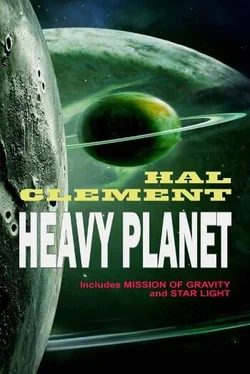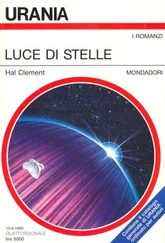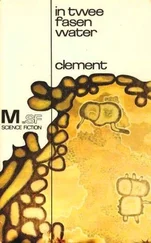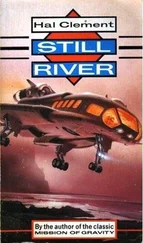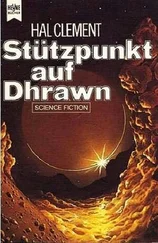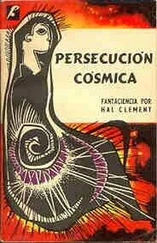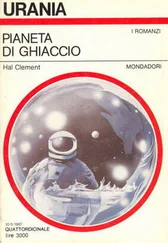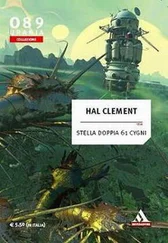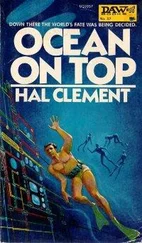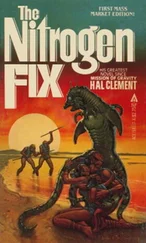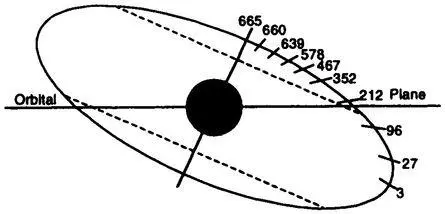
I can even justify such a planet, after a fashion, by the current(?) theories of planetary system formation. Using these, I assume that the nucleus forming the original protoplanet had an orbit of cometary eccentricity, which was not completely rounded out by collisions during the process of sweeping up nearly all the raw material in the vicinity of its sun. During the stage when its “atmosphere” extended across perhaps several million miles of space, the capture of material from orbits which were in general more circular than its own would tend to give a spin to the forming world, since objects from outside its position at any instant would have a lower velocity than those from farther in. The rotation thus produced, and increased by conservation of angular momentum as the mass shrank, would be in the opposite direction to the world’s orbital motion. That does not bother me, though; I didn’t even mention it in the story, as nearly as I can now recall. The rate of spin might be expected to increase to the point where matter was actually shed from the equator, so I gave the planet a set of rings and a couple of fairly massive moons. I checked the sizes of the rings against the satellite orbits, and found that the inner moon I had invented would produce two gaps in the ring similar to those in Saturn’s decoration. The point never became important in the story, but it was valuable to me as atmosphere; I had to have the picture clearly in mind to make all possible events and conversations consistent. The inner moon was ninety thousand miles from the planet’s center, giving it a period of two hours and a trifle under eight minutes. The quarterperiod and third-period ring gaps come about twelve and nineteen thousand miles respectively from the world’s surface. The half-period gap would fall about thirty-three thousand miles out, which is roughly where Roché’s Limit would put the edge of the ring anyway (I say roughly, because that limit depends on density distribution too.) SCALE DRAWING of MESKLIN and RING SYSTEM Inner ring reaches to less than 1,000 miles of planet’s surface; gaps are of corresponding width .

On the whole, I have a rather weird-looking object. The model I have of it is six inches in diameter and not quite two and a half thick; if I added the ring, it would consist of a paper disk about fourteen inches in diameter cut to fit rather closely around the plastic wood spheroid. (The model was made to furnish something to draw a map on; I like to be consistent. The map was drawn at random before the story was written; then I bound myself to stick to the geographic limitations it showed.) I was tempted, after looking at it for a while, to call the book Pancake in the Sky, but Isaac Asimov threatened violence.3 Anyway, it looks rather more like a fried egg.
There are a lot of characteristics other than size, though, which must be settled before a story can be written. Since I want a native life form, I must figure out just what conditions that form must be able to stand. Some of these conditions, like the temperature and gravity, are forced on me; others, perhaps, I can juggle to suit myself. Let’s see. Temperature depends, almost entirely, on how much heat a planet receives and retains from its sun. 61 Cygni is a binary system, but the two stars are so far apart that I needn?t consider the other one as an influence on this planet?s temperature; and the one which it actually circles is quite easy to allow for. Several years ago I computed, partly for fun and partly for cases like this, a table containing some interesting information for all the stars within five parsecs for which I could secure data. The information consists of items such as the distance at which an Earth-type planet would have to revolve from the star in question to have the present temperatures of Earth, Venus, and Mars, and how long it would take a planet to circle the sun in question in each such orbit. For 61 Cygni A, the three distances are about twenty-eight, thirty-nine, and sixty-nine million miles, respectively. As we have seen, 61 C?s orbit is reasonably well known; and it is well outside any of those three distances. At its closest?and assuming that the primary star is 61 A?it gets almost near enough to be warmed to be about fifty below zero, Centigrade.4 At the other end of its rather eccentric orbit, Earth at least would cool to about minus one hundred eighty, and it’s rather unlikely that this world we are discussing gets too much more out of the incoming radiation. That is a rather wide temperature fluctuation. The eccentricity of the orbit is slightly helpful, though. As Kepler’s laws demand, the world spends relatively little time close to its sun; about four fifths of its year it is outside the minus one hundred fifty degree isotherm, and it is close enough to be heated above minus one hundred for only about one hundred thirty days of its eighteen-hundred-day year — Earth days, of course. Its year uses up around one hundred forty-five thousand of its own days, the way we’ve set it spinning. For practical purposes, then, the temperature will be around minus one hundred seventy Centigrade most of the time. We’ll dispose of the rest of the year a little later. Presumably any lifeform at all analogous to our own will have to consist largely of some substance which will remain liquid in its home planet’s temperature range. In all probability, the substance in question would be common enough on the planet to form its major liquid phase. If that is granted, what substance will meet our requirements?
Isaac Asimov and I spent a pleasant evening trying to find something that would qualify. We wanted it not only liquid within our temperature limits, but a good solvent and reasonably capable of causing ionic dissociation of polar molecules dissolved in it. Water, of course, was out; on this world it is strictly a mineral. Ammonia is almost as bad, melting only on the very hottest days. We played with ammonia’s analogues from further along the periodic table — phosphine, arsine, and stibine — with carbon disulfide and phosgene, with carbon suboxide and hydrogen fluoride, with saturated and unsaturated hydrocarbons both straight and with varying degrees of chlorine and fluorine substitution, and even with a silicone or two. A few of these met the requirements as to melting and boiling points; some may even have caused dissociation of their solutes, though we had no data on that point for most. However, we finally fell back on a very simple compound. It boils, unfortunately, at an inconveniently low temperature, even though we assume a most unlikely atmospheric pressure. It cannot be expected to be fruitful in ions, though as a hydrocarbon it will probably dissolve a good many organic substances. It has one great advantage, though, from my viewpoint; it would almost certainly be present on the planet in vast quantities. The substance is methane — CH4. Like Jupiter, this world must have started formation with practically the “cosmic” composition, involving from our viewpoint a vast excess of hydrogen. The oxygen present would have combined with it to form water; the nitrogen, to form ammonia; the carbon to form methane and perhaps higher hydrocarbons. There would be enough hydrogen for all, and plenty to spare — light as it is, even hydrogen would have a hard time escaping from a body having five thousand times the mass of Earth once it had cooled below red heat — at first, that is. Later, when the rotational velocity increased almost to the point of real instability, it would be a different story; but we’ll consider that in a moment. However, we have what seems to be a good reason to expect oceans of methane on this world; and with such oceans, it would be reasonable to expect the appearance and evolution of life forms using that liquid in their tissues. But just a moment. I admitted a little while ago that methane boils at a rather lower temperature than I wanted for this story. Is it too low? Can I raise it sufficiently by increasing the atmospheric pressure, perhaps? Let’s see. The handbook lists methane’s critical temperature as about minus eighty-two degrees Centigrade. Above that temperature it will always be a gas, regardless of pressure; and to bring its boiling point up nearly to that value, a pressure about forty-six times that of our own atmosphere at sea level will be needed. Well, we have a big planet, which should have held on to a lot of its original gases; it ought to have a pressure of hundreds or even thousands of atmospheres — whoops! we forgot something. At the equator, effective gravity — gravity minus centrifugal effect — is three times Earth normal. That, plus our specification of temperature and composition of the atmosphere, lets us compute the rate at which atmospheric density will decrease with altitude. It turns out that with nearly pure hydrogen, three g’s, and a temperature of minus one hundred fifty for convenience, there is still a significant amount of atmosphere at six-hundred-miles altitude if we start at forty-odd bars for surface pressure— and at six hundred miles above the equator of this planet the centrifugal force due to its rotation balances the gravity! If there had ever been a significant amount of atmosphere at that height, it would long since have been slung away into space; evidently we cannot possibly have a surface pressure anywhere near forty-six atmospheres. Some rough slide-rule work suggests eight atmospheres as an upper limit?I used summer temperatures rather than the annual mean. At that pressure methane boils at about minus one hundred forty-three degrees, and for some three hundred Earth days, or one-sixth of each year, the planet will be in a position where its sun could reasonably be expected to boil its oceans. What to do?
Читать дальше
